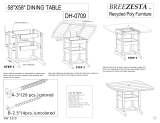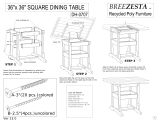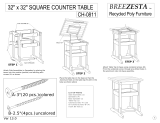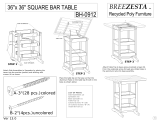Page is loading ...

May 15, 2017
Lit. No. 94840, Rev. 04
UTS 696 Under Tailgate Spreader
#94850, 94851
Installation Instructions
Western Products, PO Box 245038, Milwaukee, WI 53224‑9538 • www.westernplows.com
These Installation Instructions are for WESTERN® UTS 696 Under Tailgate Spreaders
with serial numbers 0216 and higher.
A DIVISION OF DOUGLAS DYNAMICS, LLC
CAUTION
Read this document before installing
or operating the spreader.

Lit. No. 94840/94839, Rev. 04 2 May 15, 2017
SAFETY DEFINITIONS
NOTE: Indicates a situation or action that can lead
to damage to your spreader and vehicle or other
property. Other useful information can also be
described.
SAFETY
WARNING/CAUTION LABELS
Become familiar with and inform users about the
warning and caution labels on the spreader.
NOTE: If labels are missing or cannot be read, see
your sales outlet.
CAUTION
Indicates a potentially hazardous situation
that, if not avoided, may result in minor or
moderate injury. It may also be used to alert
against unsafe practices.
WARNING
Indicates a potentially hazardous situation
that, if not avoided, could result in death or
serious personal injury.
Warning/Caution Label
AUGER UNLOCKED AUGER LOCKED
WARNING
Lock out auger before servicing,
cleaning or clearing jam.
Lock Out Procedure Label

Lit. No. 94840/94839, Rev. 04 3 May 15, 2017
SAFETY PRECAUTIONS
Improper installation and operation could cause
personal injury and/or equipment and property
damage. Read and understand labels and the
Owner's Manual before installing, operating, or
making adjustments.
WARNING
• Driver to keep bystanders minimum of
25 feet away from operating spreader.
• Before working with the spreader, secure all
loose-tting clothing and unrestrained hair.
• Before operating the spreader, verify that all
safety guards are in place.
• Before servicing the spreader, wait for
conveyor, auger, and spinner to stop.
• Do not climb into or ride on spreader.
WARNING
Do not install the control for this product in
the deployment path of an air bag. Refer to
vehicle manufacturer's manual for air bag
deployment area(s).
CAUTION
If rear directional, CHMSL light, or brake
stoplights are obstructed by the spreader, the
lights shall be relocated, or auxiliary directional
or brake stoplights shall be installed.
WARNING
Overloading could result in an
accident or damage. Do not exceed
GVWR or GAWR ratings as found
on the driver‑side vehicle door
cornerpost. See Loading section to determine
maximum volumes of spreading material.
CAUTION
During the hopper installation we recommend
the addition of an OSHA compliant Backup
Alarm. This alarm is required for OSHA
governed employers.
CAUTION
Disconnect electric and/or hydraulic power
and tag out if required before servicing or
performing maintenance.
NOTE: Lubricate grease ttings after each use.
Use a good quality multipurpose grease.
FUSES
The electrical system contains several blade-style
automotive fuses. If a problem should occur and
fuse replacement is necessary, the replacement fuse
must be of the same type and amperage rating as
the original. Installing a fuse with a higher rating can
damage the system and could start a re.
CAUTION
DO NOT leave unused material in
hopper. Material can freeze or solidify,
causing unit to not work properly.
Empty and clean after each use.
CAUTION
• Do not operate a spreader in need of
maintenance.
• Before operating the spreader, reassemble
any parts or hardware removed for cleaning
or adjusting.
• Before operating the spreader, remove
materials such as cleaning rags, brushes,
and hand tools from the spreader.
• Before operating the spreader, read the
engine owner's manual, if so equipped.
• While operating the spreader, use auxiliary
warning lights, except when prohibited by law.
• Tighten all fasteners according to the
Torque Chart. Refer to Torque Chart for the
recommended torque values.
WARNING
Hydraulic uid under pressure can
cause skin injection injury. If you are
injured by hydraulic uid, get medical
attention immediately.

Lit. No. 94840/94839, Rev. 04 4 May 15, 2017
SAFETY
PERSONAL SAFETY
• Remove ignition key and put the vehicle in park or
in gear to prevent others from starting the vehicle
during installation or service.
• Wear only snug-tting clothing while working on
your vehicle or spreader.
• Do not wear jewelry or a necktie, and secure long
hair.
• Wear safety goggles to protect your eyes from
battery acid, gasoline, dirt, and dust.
• Avoid touching hot surfaces such as the engine,
radiator, hoses, and exhaust pipes.
• Always have a re extinguisher rated BC handy,
for ammable liquids and electrical res.
FIRE AND EXPLOSION
Be careful when using gasoline. Do not use gasoline
to clean parts. Store only in approved containers away
from sources of heat or ame.
CELL PHONES
A driver's rst responsibility is the safe operation of
the vehicle. The most important thing you can do
to prevent a crash is to avoid distractions and pay
attention to the road. Wait until it is safe to operate
Mobile Communication Equipment such as cell phones,
text messaging devices, pagers, or two-way radios.
WARNING
Gasoline is highly ammable and gasoline
vapor is explosive. Never smoke while
working on vehicle. Keep all open ames
away from gasoline tank and lines. Wipe up
any spilled gasoline immediately.
VENTILATION
BATTERY SAFETY
NOISE
Airborne noise emission during use is below 70 dB(A)
for the spreader operator.
VIBRATION
Operating spreader vibration does not exceed 2.5 m/s2
to the hand-arm or 0.5 m/s2 to the whole body.
CAUTION
Batteries normally produce explosive gases
which can cause personal injury. Therefore,
do not allow ames, sparks, or lit tobacco
to come near the battery. When charging or
working near a battery, always cover your
face and protect your eyes, and also provide
ventilation.
• Batteries contain sulfuric acid, which burns
skin, eyes, and clothing.
• Disconnect the battery before removing or
replacing any electrical components.
WARNING
Vehicle exhaust contains lethal fumes.
Breathing these fumes, even in low
concentrations, can cause death. Never
operate a vehicle in an enclosed area without
venting exhaust to the outside.

Lit. No. 94840/94839, Rev. 04 5 May 15, 2017
SAFETY
TORQUE CHART
1/4-20 10
91
54
1/4-28 12
11
71
5/16-1
81
50 212
5/16-2
41
70 240
3/8-16 269 376
3/8-24 29
74
20
7/16-1442
96
06
7/16-20
9/16-12
9/16-18
5/8-11
5/8-18
3/4-10
3/4-16
7/8-9
7/8-14 47
46
69
64
49
091-8
1-12 70
49
95
1/2-13
1/2-20
11.9
13.7
24.6
27.3
43.6
26.9
53.3
93
148
49.4
69.8
77.9
106.4
120.0
8.4
9.7
17.4
19.2
30.8
35.0
49.4
55.2
75.3
85.0
M6 x 1.00
M12 x 1.75
M8 x 1.25
M14 x 2.00
M10 x 1.50
M27 x 3.00
M22 x 2.50
M30 x 3.50
M24 x 3.00
M20 x 2.5011.1
19.5
38.5
67
107
7.7
613
778
1139
1545
450
428
562
796
1117
M33 x 3.50
M36 x 4.00
2101
2701
1468
1952
325
M16 x 2.00 231167
M18 x 2.50 318222
Recommended Fastener Torque Chart
Size Size
Torque (ft-lb)
Grade
5
Grade
8
Metric Fasteners Class 8.8 and 10.9
These torque values apply to fasteners
except those noted in the instructions.
Torque (ft-lb)
Grade
5
Grade
8
Size Size
Torque (ft-lb)
Class
8.8
Class
10.9
Torque (ft-lb)
Class
8.8
Class
10.9
Inch Fasteners Grade 5 and Grade 8
CAUTION
Read instructions before assembling.
Fasteners should be nger tight until
instructed to tighten according to the Torque
Chart. Use standard methods and practices
when attaching spreader, including proper
personal protective safety equipment.

Lit. No. 94840/94839, Rev. 04 6 May 15, 2017
LOADING
This Owner's Manual covers vehicles that have been
recommended for carrying the hopper spreader. Please
see your local dealer for proper vehicle applications.
CERTIFICATION
WARNING
Overloading could result in an accident or
damage. Do not exceed GVWR or GAWR as
found on the driver‑side cornerpost of vehicle.
WARNING
New untitled vehicle installation of a spreader
requires National Highway Trafc Safety
Administration altered vehicle certication
labeling. Installer to verify that struck load of
snow or ice control material does not exceed
GVWR or GAWR rating label and complies
with FMVSS.
CAUTION
Read and adhere to manufacturer's
ice‑control material package
labeling, including Material Safety
Data Sheet requirements.
MATERIAL WEIGHTS
Density
Material (lb/ft3)(lb/yd3)(kg/m3)
Salt 80 2160 1282
Sand 100 2700 1602
Material densities are approximate and are based on dry,
loose material. It is the responsibility of the operator to
know the weight of the material to be spread and the vehicle
carrying capacity.

Lit. No. 94840/94839, Rev. 04 7 May 15, 2017
3. Lift the spreader into position, clamp the spreader
in place, and verify proper lid movement.
MOUNTING THE SPREADER
Mounting the Spreader
NOTE: Periodically throughout the snow and ice
control season, verify that mounting devices
are secure.
1. Assemble the mounts by rst mating the two
halves together as shown. Next, insert the hinge
pin and secure it with the supplied hairpin cotter.
Repeat this step to assemble both mounts.
2. Bolt the mount assemblies to the spreader with
two 1/2" carriage bolts and 1/2" locknuts per side.
The recommended conguration for the mounts
is to position the spreader mount above the truck
mount.
CAUTION
Before lifting, verify that the hopper is empty
of material. The lifting device must be able to
support the spreader's weight.
Vehicle Side
(Preferred)
Spreader Side

Lit. No. 94840/94839, Rev. 04 8 May 15, 2017
4. Drill and bolt or weld the remaining half of the
mounts to the rear cornerpost of the dumpbody.
The clearance from the bottom of the tailgate or
tailgate latch (whichever is lower) to the top of
the spreader lid should be between 1/4" and 5/8".
If dumping over tailgate, please check for
clearance of tailgate over spreader lid. Also install
the support bars from the spreader to the rear
cornerpost of the dump body.
NOTE: Pay special attention when drilling or
clamping dissimilar metals to aluminum bodies.
Galvanic corrosion can occur if not handled
properly. Contact vehicle manufacturer for
recommended attachment practices.
MOUNTING THE SPREADER
1/4" to 5/8"
Dump Body
Ta
ilgate
Bolted
in place.
Drill and
bolt support
bars to dump body.
CAUTION
Before drilling holes, check to be sure that no
vehicle wiring or other components could be
damaged.

Lit. No. 94840/94839, Rev. 04 9 May 15, 2017
ATTACHING THE SPINNER
Spinner Assembly Instructions
1. Pin the spinner assembly to the main trough
assembly using two 3/4" pins and four hairpin
cotters.
3/4" Pins
Hairpin
Cotters
Hairpin
Cotters
(Continued on next page.)

Lit. No. 94840/94839, Rev. 04 10 May 15, 2017
ATTACHING THE SPINNER
2. Install the parallel brackets to the truck frame.
Sequence of assembly is as follows:
a. Position the parallel bracket(s) to line up with
the spinner frame edge. With the spinner
level, position the parallel bracket such that
"D" is equal to "D1" and "L" is equal to "L1."
The closer to equal the dimensions, the
closer to level the spinner will stay to the
road throughout the range of dumping angle.
Clamp the bracket(s) in place.
1/4" x 3/4"
Screws
Corner
Shield
Dump Body Tailgate
Preferred Method
or
Parallel Bracket
D
L
L
1
D1
b. Attach the parallel rods through the spinner
bow and parallel bracket using washers and
cotter pins. After attaching, clamp the parallel
rods together.
c. Verify leveling action by raising the dump. Be
alert to any potential interference. Verify that
the motor does not contact the road with the
dumpbody fully raised. After checking, weld or
bolt the parallel bracket in place, and weld or
permanently x the parallel bars together.
Alternate To Parallel Bar Use:
Weight front of spinner until it is level.
For more ground clearance, cut top holes off of
spinner supports and use lower holes.
Corner Shield Installation Instructions
1. Install the corner shields as shown. Either weld or
bolt them in place using the 1/4" x 3/4" self drilling
and tapping screws.
2. Keep the bottom of the shield clear of the corner
radius.
3. Verify clearance and dumpbody tailgate operation
before permanently attaching the corner shields.

Lit. No. 94840/94839, Rev. 04 11 May 15, 2017
HYDRAULIC UNIT INSTALLATION INSTRUCTIONS
Hydraulic Unit Installation
Recommended sequence of installation is as follows:
1. Pump (not provided).
2. Install hydraulic reservoir (not provided).
3. Install cab control valve (optional).
4. Install hydraulic hoses (not provided).
5. Fill hydraulic reservoir and check system.
Pump
Because of the wide range of possible installations
of this spreader, no pump is supplied with the unit.
If your truck does not have a pump suitable to your
application, one may be purchased from a local
truck equipment supplier. This pump should produce
25 GPM at 1,500 psi at normal operating speed and
have 1" NPT suction and discharge ports.
Hydraulic Reservoir Installation
Position the reservoir outlet as high, or higher than,
the pump inlet. Keep the hose distance as short as
possible. (Reservoir used should have a capacity of
1-1/2 to 2 times the pump maximum ow rate in GPM.)
Auger Hydraulic Motor Plumbing
WARNING
Hydraulic uid under pressure can cause skin
injection injury. If you are injured by hydraulic
uid, get medical attention immediately.
Cab Control Valve Installation
1. With the seat fully forward, select a suitable
location to mount the cab control valve allowing for
the operator to adjust the control and to turn it ON
and O FF.
2. Check for clearance with ALL controls in the cab.
3. Under the cab, check for interference with
transmission, etc.
4. Check to see that the cab control valve location
does not interfere with entering or leaving cab.
5. Fabricate a bracket to mount cab control valve in
selected location.
6. Insert a grommet into all holes drilled for this
installation.
7. Mount valve and plumb pump and motor to valve.
Plumb port "T" to reservoir, Port "P" to pressure
side of pump, Port "A" of the valve to Port "B" of
the auger motor, and Port "S" of the valve to Port
"B" of the spinner motor.
8. Check machine for proper rotation of drive shafts
and hydraulic leaks.
Spinner Hydraulic Motor Plumbing
Ro
tation
From
Valve
To
Tank
Port A
Port B
Flow
Direction
(View from the ground, looking up.)
Port B
From Valve
To Tank
Flow
Direction
Port A
Ro
tation

Lit. No. 94840/94839, Rev. 04 12 May 15, 2017
HYDRAULIC CIRCUIT DIAGRAM
T
P
A
S
TANK
Typical Hydraulic Circuit
Dedicated Fixed Displacement Pump
PUMP
23 GPM
@
1500 psi VALVE
Rated to 40 GPM
@
1500 psi
Auger Motor
Spinner Motor
Controlled Flow to
Spinner Motor:
10 GPM (max.) @ 1500 psi
Return Flow
to Tank
Return Flow
to Tank
Excess Flow
to Tank
Controlled Flow to
Auger Motor:
15 GPM (max.) @ 1500 psi
Inlet Flow
from
Tank

Lit. No. 94840/94839, Rev. 04 13 May 15, 2017
Verify all nuts and bolts are tight.
Verify spinner is level and has adequate clearance
through the entire range of dumping motion.
Verify hydraulic hoses are properly routed and do
not drag or interfere with dump body action.
Verify proper spinner and auger rotation.
Ensure there are no hydraulic leaks.
Verify proper ow control valve function.
Verify hydraulic oil tank level.
Verify all factory warning labels and instructions
are in place and are readable.
Ensure that Warranty Card and Owner's Manual
Kit are given to purchaser.
PRE‑DELIVERY CHECK LIST

Lit. No. 94840, Rev. 04 May 15, 2017
A DIVISION OF DOUGLAS DYNAMICS, LLC
Western Products
PO Box 245038
Milwaukee, WI 53224-9538
www.westernplows.com
Copyright © 2017 Douglas Dynamics, LLC. All rights reserved. This material may not be reproduced or copied, in whole or in part, in any
printed, mechanical, electronic, lm or other distribution and storage media, without the written consent of Western Products. Authorization to
photocopy items for internal or personal use by Western Products outlets or spreader owner is granted.
Western Products reserves the right under its product improvement policy to change construction or design details and furnish equipment
when so altered without reference to illustrations or specications used. Western Products or the vehicle manufacturer may require or
recommend optional equipment for spreaders. Do not exceed vehicle ratings with a spreader. Western Products offers a limited warranty
for all spreaders and accessories. See separately printed page for this important information. The following is a registered (®) trademark of
Douglas Dynamics, LLC: WESTERN®.
Printed in U.S.A.

May 15, 2017
Lit. No. 94839, Rev. 04
Fisher Engineering 94750, 94751
50 Gordon Drive, Rockland, Maine 04841-2139 • www.sherplows.com
UTS 696 Under Tailgate Spreader
Installation Instructions
These Installation Instructions are for FISHER® UTS 696 Under Tailgate Spreaders
with serial numbers 0216 and higher.
CAUTION
Read this document before installing
or operating the spreader.
A DIVISION OF FISHER, LLC

Lit. No. 94839, Rev. 04 May 15, 2017
A DIVISION OF FISHER, LLC
Fisher Engineering
50 Gordon Drive
Rockland, ME 04841-2139
www.sherplows.com
Copyright © 2017 Douglas Dynamics, LLC. All rights reserved. This material may not be reproduced or copied, in whole or in part, in any
printed, mechanical, electronic, lm or other distribution and storage media, without the written consent of Fisher Engineering. Authorization
to photocopy items for internal or personal use by Fisher Engineering outlets or spreader owner is granted.
Fisher Engineering reserves the right under its product improvement policy to change construction or design details and furnish equipment
when so altered without reference to illustrations or specications used. Fisher Engineering or the vehicle manufacturer may require or
recommend optional equipment for spreaders. Do not exceed vehicle ratings with a spreader. Fisher Engineering offers a limited warranty
for all spreaders and accessories. See separately printed page for this important information. The following is a registered (®) trademark of
Douglas Dynamics, LLC: FISHER®.
Printed in U.S.A.
/









